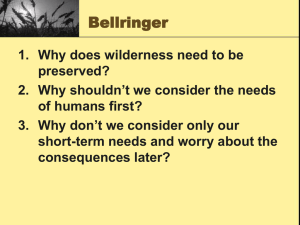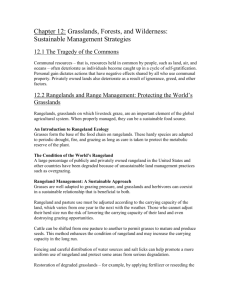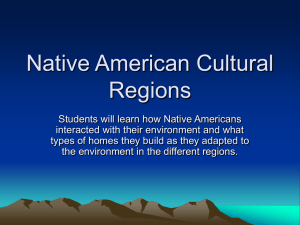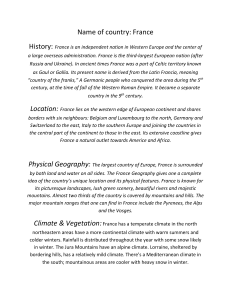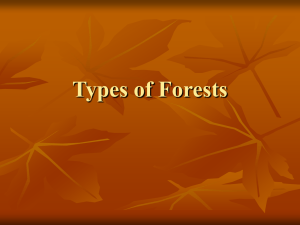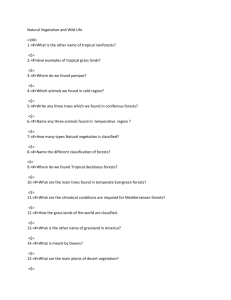Land
advertisement
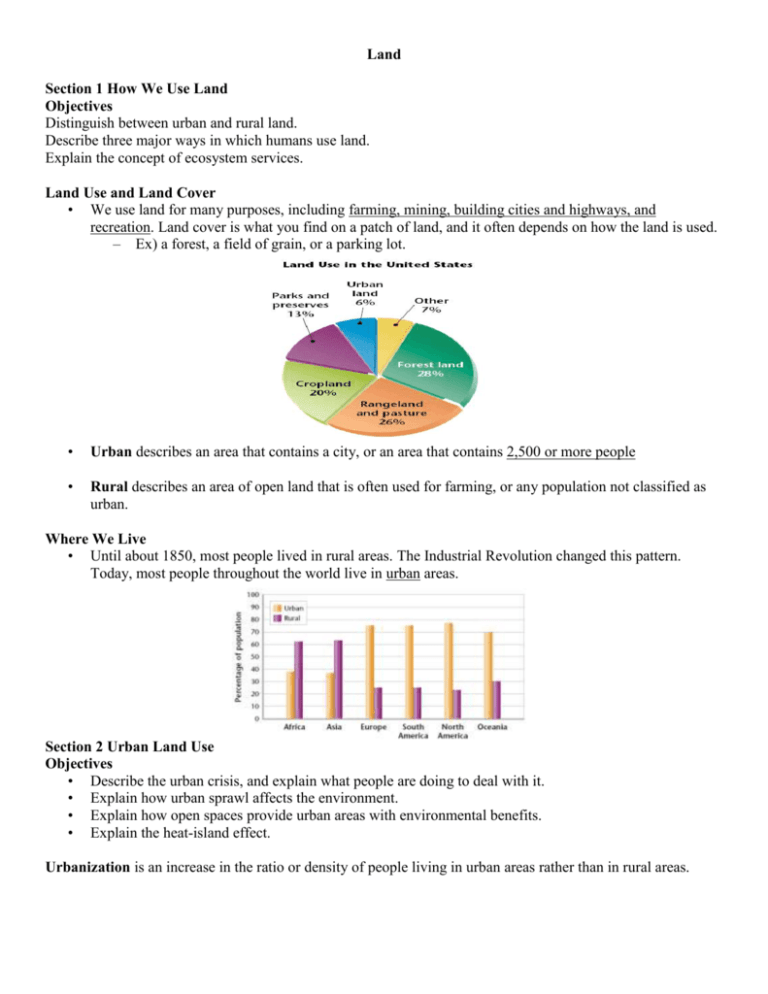
Land Section 1 How We Use Land Objectives Distinguish between urban and rural land. Describe three major ways in which humans use land. Explain the concept of ecosystem services. Land Use and Land Cover • We use land for many purposes, including farming, mining, building cities and highways, and recreation. Land cover is what you find on a patch of land, and it often depends on how the land is used. – Ex) a forest, a field of grain, or a parking lot. • Urban describes an area that contains a city, or an area that contains 2,500 or more people • Rural describes an area of open land that is often used for farming, or any population not classified as urban. Where We Live • Until about 1850, most people lived in rural areas. The Industrial Revolution changed this pattern. Today, most people throughout the world live in urban areas. Section 2 Urban Land Use Objectives • Describe the urban crisis, and explain what people are doing to deal with it. • Explain how urban sprawl affects the environment. • Explain how open spaces provide urban areas with environmental benefits. • Explain the heat-island effect. Urbanization is an increase in the ratio or density of people living in urban areas rather than in rural areas. The Urban Crisis • A rapidly growing population can overwhelm the infrastructure, leading to traffic jams, substandard housing, and polluted air and water. • Infrastructure is the basic facilities of a country or region, such as roads, bridges, sewers, and railroads. • Urban crisis - When more people live in a city than its infrastructure can support, the living conditions deteriorate. Urban Sprawl - the rapid spread of a city into adjoining suburbs and rural areas. Development on Marginal Lands • Many cities were first built where there was little room for expansion. As the cities grew, suburbs were often built on marginal land, or land that is poorly suited for building. For example, Los Angeles was built in a basin, and has expanded onto slopes that are prone to landslides. Structures built on marginal land can become difficult or impossible to repair and can be expensive to insure. Other Impacts of Urbanization • Environmental conditions in the center of a city are different from those of the surrounding countryside, as cities both generate and trap more heat. • Heat island is an area in which the air temperature is generally higher than the temperature of surrounding rural areas. Heat is generated by the infrastructure that makes a city run. Roads and buildings absorb and retain heat longer than vegetation does. Scientists are beginning to see that heat islands can affect local weather patterns. Hot air rises over a city, cooling as it rises, and eventually produces rain clouds. • The heat-island effect may be moderated by planting trees for shade and by installing rooftops gardens. Urban Planning • Land-use planning is a set of policies and activities related to potential uses of land that is put in place before an area is developed. The federal government requires developers to prepare detailed reports assessing the environmental impact of many projects, and the public has a right to comment on these reports. Developers, city governments, local businesses, and citizens often disagree about land-use plans. Transportation • Most cities in the United States are difficult to travel in without a car. Most cities in the United States were constructed after the invention of the automobile. In addition, availability of land was not a limiting issue, so many American cities sprawl over large areas. In many cities, mass transit systems (buses and trains) were constructed in order to get people where they wanted to go. • Mass transit systems save energy, limit the loss of land to roadways and parking lots, reduce highway congestion, and reduce air pollution. Where the construction of mass transit systems is not reasonable, carpooling is an important alternative. Open Space • Open space is land within urban areas that is set aside for scenic and recreational enjoyment. Ex) parks, public gardens, and bicycle and hiking trails. • Open spaces left in their natural conditions are often called greenbelts. The plants in open spaces absorb carbon dioxide, produce oxygen, filter out pollutants from air and water, and help keep a city cooler in the summer. Open spaces, especially those with vegetation, also reduce drainage problems by absorbing more of the rainwater runoff from building roofs, asphalt, and concrete resulting in less flooding. These open spaces also proved urban dwellers with much-needed places for exercise and relaxation. Section 3 Land Management and Conservation Objectives • Explain the benefits of preserving farmland. • Describe two ways that rangeland can be managed sustainably. • Describe the environmental effects of deforestation. • Explain the function of parks and of wilderness areas. Land Management The main categories of rural land are farmland, rangeland, forest land, national and state parks, and wilderness Farmlands • Farmland is land that is used to grow crops and fruit. However, in some places, urban development threatens some of the most productive farmland. In 1996, the U.S. government established a national Farmland Protection Program to help state, county, and local governments protect farmland in danger of being paved over or otherwise developed. Rangelands • Land that supports different vegetation types like grasslands, shrublands, and deserts and that is not used for farming or timber production is called rangeland. Rangelands can be arid, like the rangelands in the desert Southwest, or relatively wet, like the rangelands of Florida. The most common human use of rangeland is for the grazing of livestock. Problems on the Range • Overgrazing is the depletion of vegetation due to the continuous feeding of too many animals. Overgrazing often results in changes in the plant community. Less desirable plants may invade the area and replace more-desirable plant species. In cases of severe overgrazing, all the vegetation that covers the land is eaten. Once the plants are gone, there is nothing to keep the soil from eroding. Maintaining the Range • Improving rangeland that has been degraded by overgrazing often includes methods such as killing invasive plants, planting native vegetation, and fencing areas to let them recover to the state they were in before they were overgrazed. Rangeland can also be left unused for periods of time so that the vegetation can recover. Forest Lands • Trees are harvested to provide products we use everyday, such as paper, furniture, and lumber and plywood for our homes. There are many ecosystem services provided by forests. However, one of the most important is the removal of CO2 from the air. Harvesting Trees • The timber industry classifies forest lands into three categories: • Virgin forests: forests that have never been cut. • Native forests: forests that are planted and managed. • Tree farms: areas where trees are planted in rows and harvested like other crops. • The two most widely used methods of harvesting trees are clear-cutting and selective cutting. • Clear-cutting is the process of removing all of the trees from an area of land. Clear-cutting large areas destroys wildlife habitat and causes soil erosion. • Selective cutting is the process of cutting and removing only middle-aged or mature trees. It is more expensive than clear-cutting, but is usually much less destructive. Deforestation • Deforestation is the process of clearing forests. Most countries become severely deforested as populations expand and the demand for forest products increases. Forests are cleared to convert the land into farmland, and to make space for roads, homes, factories, and office buildings. Deforestation reduces wildlife habitat. • When forests are cleared from hillsides, soil erosion usually results if the area is not quickly planted with a cover crop. Without tree roots to hold the soil in place, it is easily washed or blown away into the valley below. The rate of deforestation is especially high in tropical rain forests, where the soil is relatively thin. Farmers who clear forests in these areas must always move from one plot of land to another, clearing more forest land each time. Reforestation • Reforestation is the reestablishment and development of trees in a forest land. In some places, reforestation is happening faster than trees are being cut down. Parks and Preserves • In the 1870s, a group of explorers approached Congress with news of a magnificent expanse of land in Wyoming and Montana they believed would be damaged by the development that had changed the northeastern United States. Congress agreed to protect this land by setting it aside for the public to use and enjoy, and the first national park, Yellowstone, was created. Today, the U.S. has over 50 national parks. • Most public lands are not as protected as the national parks are. Some public lands are leased to private companies for logging, mining, and ranching. Others are maintained for hunting, fishing, wild-life refuges, or to protect endangered species. Wilderness • The U.S. Wilderness Act, passed in 1964, designated certain lands as wilderness areas. Wilderness is a region that is not cultivated and that is not inhabited by humans. • So far, 475 regions covering 32 million acres have been designated as wilderness in the United States. These areas are open to hiking, fishing, and camping. Building roads or structures and using motorized equipment is not allowed in wilderness areas.
